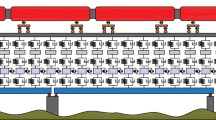Abstract
Floating slab tracks have been widely adopted in rail transit viaducts to reduce the bridge vibration and structure-borne noise. To calculate the vibration of the coupled track-bridge systems, both time-domain and frequency-domain methods can be applied although their relative performance is not very clear. This study aims to compare the two methods and then provide some guidelines in choosing the appropriate method in the vibration prediction. The principle and methodology of the two calculation methods are firstly introduced, and the models for the train, track and bridge are developed using the same parameters. Comparison is made of the vibration of bridge and floating slab obtained from the two methods with different train speeds. It is found that the results from the two methods show good consistency in the frequency region above 20 Hz. It is shown that the results from different loading cases should be averaged with care when the frequency domain method is adopted. When using irregularity measured on site, the simulated vibration of floating slab and bridge from the two methods match well with the experimental results.
Access this chapter
Tax calculation will be finalised at checkout
Purchases are for personal use only
Similar content being viewed by others
References
Li Q, Song X, Wu D (2014) A 2.5-dimensional method for the prediction of structure-borne low-frequency noise from concrete rail transit bridges. J Acoust Soci Am 135(5):2718–2726
Xu YL, Li Q, Wu DJ et al (2010) Stress and acceleration analysis of coupled vehicle and long-span bridge systems using the mode superposition method. Eng Struct 32(5):1356–1368
Li XZ, Liang L, Wang DX (2018) Vibration and noise characteristics of an elevated box girder paved with different track structures. J Sound Vib 425:21–40
Li Q, Wu DJ (2013) Analysis of the dominant vibration frequencies of rail bridges for structure-borne noise using a power flow method. J Sound Vib 332(18):4153–4163
Li Q, Xu Y L, Wu DJ et al (2010) Computer-aided nonlinear vehicle-bridge interaction analysis. J Vib Control 16(12)
Wu TX, Thompson DJ (2001) Vibration analysis of railway track with multiple wheels on the rail. J Sound Vib 239(1):69–97
Li Q, Li WQ, Wu DJ et al (2016) A combined power flow and infinite element approach to the simulation of medium-frequency noise radiated from bridges and rails. J Sound Vib 365:134–156
Li Q, Dai B, Zhu Z et al (2022) Comparison of vibration and noise characteristics of urban rail transit bridges with box-girder and U-shaped sections. Appl Acoust 186
Author information
Authors and Affiliations
Corresponding author
Editor information
Editors and Affiliations
Rights and permissions
Copyright information
© 2024 The Author(s), under exclusive license to Springer Nature Singapore Pte Ltd.
About this paper
Cite this paper
Song, Q., Li, Q. (2024). Comparison of Vibration Characteristics of Floating Slab Track in Rail Transit Viaduct with Time-Domain and Frequency-Domain Models. In: Sheng, X., et al. Noise and Vibration Mitigation for Rail Transportation Systems. IWRN 2022. Lecture Notes in Mechanical Engineering. Springer, Singapore. https://doi.org/10.1007/978-981-99-7852-6_76
Download citation
DOI: https://doi.org/10.1007/978-981-99-7852-6_76
Published:
Publisher Name: Springer, Singapore
Print ISBN: 978-981-99-7851-9
Online ISBN: 978-981-99-7852-6
eBook Packages: EngineeringEngineering (R0)




